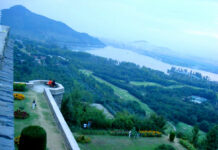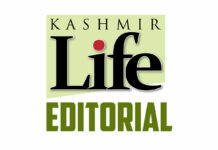
For a moment, it sounds fiction. To run a diesel generator in Rainwari hospital, Srinagar will have to secure fuel from Leh. To quench thirst in Batamaloo, a grey-haired old man on his raft will come from Handwara. Or someday it will be less time consuming to fly to Delhi than to reach Pampore from Hyderpora.
But this is just a bit of what Kashmir witnessed in the historic flood that marooned the capital. We had women barely out of operation theatres being shifted bleeding out of the wards to rafts and then to the make-shift hospital and finally to another hospital for re-stitching them! People who make-believe that this was the once-in-a-century experience, have no idea of history books. This has happened for the first time.
The most important and equally historic was the situation in which it took place and the ways and means that people used to manage it. And it is there the real strength and resilience of its people lies.
The government in place knew everything. It knew the discharge of the river and the catastrophe it wrecked in south Kashmir for four days. Even the best and smartest in the government could not reach those places despite the best efforts. It knew the capacity in and around Srinagar that the waterways can manage. But what it lacked was mathematics: they all were in the delusion that Srinagar is safe. They slept in the ivory towers and woke up in a panic when the glasses were cracking. Then, some of them were found being carried in earth-remover mouths!
In the last more than two decades, the security situation has created a massive human resource that was expected to be of some help. More than 100 thousand strong police should have led the efforts but that was grounded as its installations were marooned. They wanted boats but could not think of rafts!
The second major solace, especially for the government, was that the army will come to the rescue of the people. It did. But people in policy-making were perhaps oblivious of the fact that the army was grappled with the serious crisis in its own garrisons. Most of its base garrison at Batawara was literally decimated especially the sub-corps area. A vast area housing its ammunition depots were underwater. Water came at such a speed that salvaging part of it became a problem. While its columns in Srinagar and outside were seeking help, rescue and food, the situation pressurized it to stand guard of its assets for which the choppers were used even during nights. Despite all this, the army managed to rescue lot many people from the marooned people. Though quite a few locals could get its help, the army did manage to rescue the tourists, government officials and non-local workers from the marooned areas. This helped Kashmir stay proud as its age-old hospitality survived without a taint.
While doing this, however, somebody in the systems played mischief. Most of the army boats and choppers were behaving as outposts of various Delhi based TV channels. Specialists in hit-and-run journalism, they would care less for a thirsty person being brought out and would seek their response about the future relationship of Kashmiri civilians with the soldiers. Adding to the crisis were a set of narrow-minded, ivory-towered specialists ridiculing the scene they had filmed.
Floods had created a situation that hundreds of soldiers were seen resting without a guard at the flood spill channel dyke bordering the devastated Jawahar Nagar. Busy fighting the waters, not many watched this propaganda, especially in the city. There was a serious threat to peace had the power supply lines been intact or the cable networks working. A few days later, however, it did create a situation that people beat every person moving around with a camera – a situation that deprived Kashmir of recording its own history of the worst times ever.
With every shred of governance washed down and all the possible cushions floating around, Kashmir had to fight its existential threat. Notwithstanding the immense losses that Kashmir suffered on the economic front – all the business hubs are decimated so are the crops, and losing everything from historic records to land records, it was the life that was paramount.
It was this battle for saving lives that offered the world the first-hand experience of the resilience of Kashmir. They knew that government is not the only thing that floats and used every single element that can be used to ferry people around. Wooden plates on heaps of used water bottles, empty fertilizer drums, water tanks, and foam mattresses, coils of thin-foam layers, trucks, tractors, and tyre tubes were converted into canoes, and rafts. And then people started flying in rubble boats. This all helped them get people out of the waters that many thought had inundated Srinagar for the remaking of Satisar.
There were at least four casualties in making all this happen. But the overall death toll from Kashmir is not a fraction of what it could have done has it not been Srinagar.
The first response to the crisis did not come from the resourceful state. It came from society itself. Overnight, mosques were converted into temporary refuges, first aid centres and relief points. There were certain mosques taking cooked food and water in boats to the marooned people.
The crisis saw the cleavages created over the years narrowing. Sikhs were hosting Muslims and a Hindu woman became a proud mother while living from a mosque relief centre. After a very long time, man saw man without the baggage of faith and ideology. The first rescue team that started operating in Srinagar was from Shopian, 55 km from here.
An old man who was rescued by volunteers from Natipora belt after four days from his attic summed up it all by telling a crowd at Nowgam: “When Dal, Jhelum and Srinagar equalled in water level, many people thought, it is already over. But I am out after four days and clearly shows they were wrong.”











